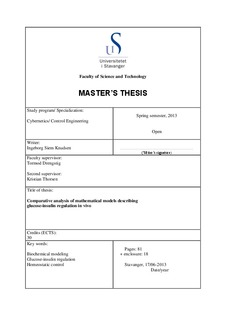Comparative analysis of mathematical models describing glucose-insulin regulation in vivo
Master thesis
Permanent lenke
http://hdl.handle.net/11250/195144Utgivelsesdato
2013-05Metadata
Vis full innførselSamlinger
- Studentoppgaver (TN-IDE) [835]
Sammendrag
In this thesis, mathematical models describing glucose-insulin regulation
within the human body have been studied. Glucoregulatory models are
valuable in diabetes related research. Monitoring glucose-insulin dynamics,
testing software and hardware related to autonomous insulin infusion, medical
testing and student training, are some of the main motivating factors
for developing physiologically accurate glucoregulatory models. In addition,
mathematical modeling of glucose control demands that the anatomical process
is studied in detail, which can increase our understanding of the process
itself. This can in turn improve the medical service for diabetic patients.
This thesis presents and evaluates the anatomical validity of six glucoregulatory
model. The evaluation will focus on the models' ability to simulate
a physiologically plausible glucose-insulin dynamics, both quantitatively and
qualitatively. Homeostatic glucose control will also be a central focus point
when evaluating the models' simulation performance. Based on this evaluation,
improvements and modifications are suggested.
This thesis is primarily a theoretical study, made up of three main segments.
The first segment will present the theoretical research conducted regarding
anatomy, biochemistry, and biochemical modeling. The second segment is
a presentation of all the six glucoregulatory models studied. The third will
present and evaluate the Matlab and Simulink simulation result, and present
a optimized model based on the model study.
Beskrivelse
Master's thesis in cybernetics

